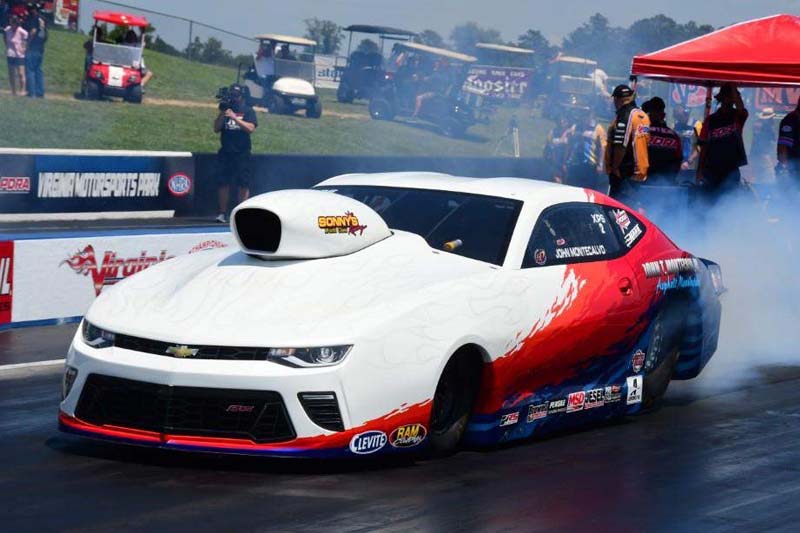NHRA PS DRIVERS ADDRESS TALK OF MOUNTAIN MOTOR/500 BLEND
 NHRA's Pro Stock has been a prime example of parity this season with ten different winners, and it took until the seventh stop on the tour before there was the first two-time winner.
NHRA's Pro Stock has been a prime example of parity this season with ten different winners, and it took until the seventh stop on the tour before there was the first two-time winner.
While point leader Greg Anderson sometimes wonders what else a class can do to be exciting with unpredictability in the winner's circle, he understands many believe its still not enough.
A rumor has been making the rounds first in Denver, and more prevalent at the Toyota NHRA Sonoma Nationals suggesting NHRA plans to follow through on their plan to handicap mountain motor Pro Stock into their 500-inch arena.
Anderson says he's not opposed to the latest idea aimed at generating excitement for the factory hot rod division.
"We’re trying to figure out the best way to get some Fords and some Chryslers back in this game, and that happens to be what most of the big motor cars are," Anderson explained. "That would be the quickest way to get Fords and Chryslers back in here and shake things up a little bit. Even if it comes out and they were to have an advantage, whatever, we’re not happy with that but it still shakes things up, and it makes a new challenge. Makes it more interesting, so we’re not against it.
"We’re kind of in favor of it and if that’s the direction [NHRA] wants to go, we’re not going to fight it. Bring it on. I don’t know where it’s at with the talks. But there’s been talks, and we’ve all said as a group here, we wouldn’t mind it."
Currently, mountain motor Pro Stock runs under the PDRA sanction, first raced on the big stage of national event drag racing in 1977 under the direction of Ted Jones and the IHRA.
These cars usually run in the 4.0-second range in the eighth-mile and in limited quarter-mile competition have run as quick as 6.2-seconds.
These cars run with engines with displacements as large as 830-cubic inches, while tipping the scales at 2,425 pounds.
Sources indicate NHRA has begun steps to secure an exhibition of the mountain motor cars during the NHRA U.S. Nationals. Whether the cars will run at their standard weight or carrying the proposed extra 200 pounds to even the playing field remains to be seen.
Chris McGaha, one the two-time winners this season, is not a fan of the proposal at all.
"It’s completely ass-backward from what everybody wants," McGaha explained. "Everybody wants the factories back involved, and that’s not a way to do it. I’m more in favor of probably running a COPO blown motor in one of these before I am that by a long shot. That’s completely a 180 from where I think the class needs to go."
"They were all joking about it saying, “we’ll carry you to the start line and put you in the car," Force revealed.
— Competition Plus (@competitionplus) July 31, 2018
"I’m not that bad off." https://t.co/HiBjK0gOsy

These cars usually run in the 4.0-second range in the eighth-mile and in limited quarter-mile competition have run as quick as 6.2-seconds. These cars run with engines with displacements as large as 830-cubic inches, while tipping the scales at 2,425 pounds.
McGaha is with Anderson in the belief the racing is the best of all the professional categories. He wonders aloud why when something needs to be fixed, Pro Stock becomes the scapegoat.
"I think the entire NHRA does [to be fixed]," McGaha continued. "But for some reason, they keep picking on Pro Stock. I think the whole deal is screwed up and when the upper management decides that they’ve screwed it up and they want to fix it maybe they will."
Defending NHRA Pro Stock champion Bo Butner spent many of his early years of drag racing watching the large displacement Pro Stockers while he was a competitor in the IHRA. He believes the key to making this proposed program work for the long-term is the direction the rulebook takes in equalizing the field for the diverse styles of Pro Stock racing.
"I just don’t really see those guys wanting to slow down," Butner explained. "We’re going to have to pick up a lot to run as fast as them, so maybe they’re willing to, but we’ll welcome any more cars that they have. We’ll have whichever combination is competitive.
"I think speeding us up would be best. I mean, who doesn’t want to go fast. I’d like to have a little more challenging drive to get down the track so that’s what you would see but don’t know how [NHRA] can do it unless they give us a power adder."
The bottom line, Anderson believes the rule makers have a tall order to fill to improve what is already in place.
"I think it’s the most competitive it’s ever been," Anderson said. "What do you want? You’ve got a different winner every week, you’ve got cars running within thousandths. That’s what you asked for, that’s what you got.
"I’m not sure what’s wrong with that, but there still seems to be talk like they really, really want more Chryslers and more Fords. I would enjoy that; I’m not going to lie. I would love running against more Chryslers and more Fords. So for that reason, we’d be alright with it."





































